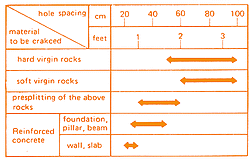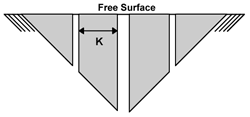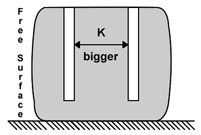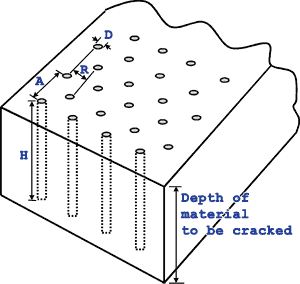where, A - hole spacing (in mm),
D - hole diameter (in mm) and
K - cracking coefficient.
Using Crackamite: Hole Design
Crackamite's effectiveness depends on the placement, diameter and depth of the holes drilled in the material. The drilling must be done in relation to the job to be performed. The design for breaking should be done according to the properties of rocks, joint, volume to be removed, secondary breaking, and work period, etc.
Effective Hole Design for Crackamite

The hole design refers to the hole diameter and hole spacing/distance. For hole diameter between 30 to 50 mm, the hole spacing (distance between holes) should be in accordance with the following formula:
| Material to be cracked | K value | Steel contained (Kg/m3) |
|---|---|---|
| Soft virgin rocks | 10 - 16 | n/a |
| Medium hardness virgin rocks | 8 - 12 | n/a |
| Hard virgin rocks | 5 - 10 | n/a |
| Plain concrete | 10 - 16 | 0 - 30 |
| Reinforced concrete | 8 - 10 | 30 - 60 |
| 6 - 8 | 60 - 100 |
K Value changes with the geometry and shape of rock or concrete


| Material to be cracked | Hole design parameters | Crackamite Consumption (Kg/m3) |
|||
|---|---|---|---|---|---|
| Diameter D (mm) | Hole Spacing A (cm) | Row Spacing R (cm) | Hole Depth H (%) | ||
| Soft stone | 35 - 40 | 40 - 100 | (0.6 - 0.9) A | 100% | 5 - 10 |
| Medium hard rock | 38 - 42 | 30 - 40 | (0.6 - 0.9) A | 105% | 12 - 22 |
| Hard granite | 38 - 42 | 25 - 40 | 30 - 80 | 105% | 18 - 25 |
| Rock cutting | 30 - 40 | 20 - 40 | (0.6 - 0.9) A | 75% | 12 - 18 |
| Plain concrete | 38 - 42 | 20 - 30 | (0.6 - 0.9) A | 80% - 85% | 12 - 18 |
| Reinforced concrete | 38 - 50 | 15 - 30 | (0.6 - 0.9) A | 90% - 95% | 18 - 25 |

Estimating Crackamite Quantity Required
Once the hole design is fixed, it is simple to figure out how much Crackamite you need. Crackamite consumption is calculated as the sum of the depths of all boreholes times the corresponding factor of the used borehole diameter. The formula is:
General coverage: Normally one 44 lb (20 kilograms) box of Crackamite can fill up to 35 linear feet (about 10 meters) of 1½ inches (3.8 centimetres) diameter holes. You might not have to fill up every hole depending on application.
As a thumb rule: Each 5 kilo bag will fill 8 linear feet of 1½" hole or 11 feet of 1¼" hole.
| Hole Diameter | 30 mm | 32 mm | 34 mm | 36 mm | 38 mm | 40 mm | 42 mm | 44 mm | 46 mm | 48 mm | 50 mm | |
|---|---|---|---|---|---|---|---|---|---|---|---|---|
| Crackamite (Kg/m³) | 1.2 | 1.3 | 1.5 | 1.7 | 1.9 | 2.1 | 2.3 | 2.5 | 2.8 | 3.0 | 3.2 | |
| Hole Depth | One Meter | |||||||||||
| Note: | You may get 3% to 6% less yield due to field conditions. | |||||||||||